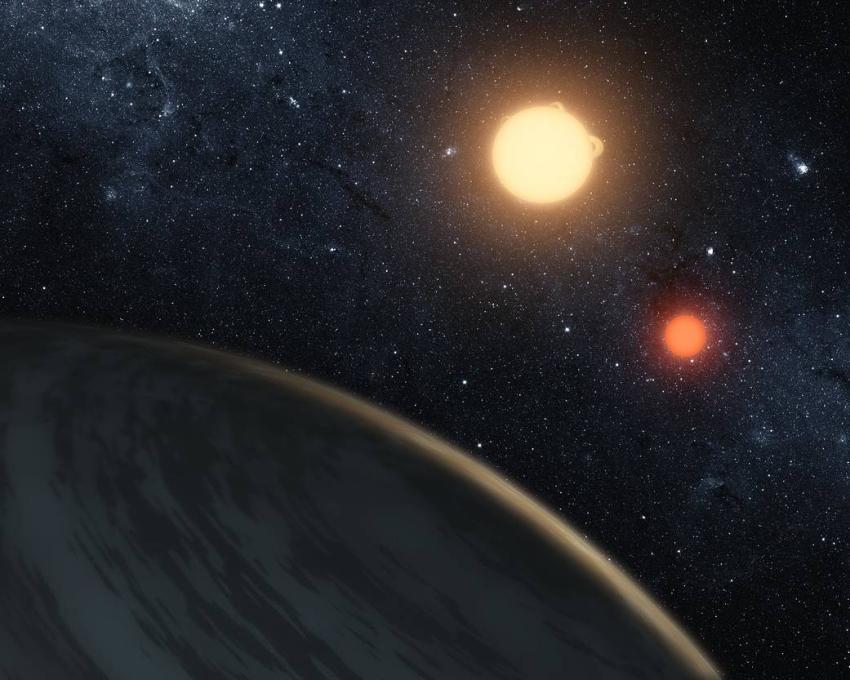A team of astronomers, led by Professor Amaury Triaud of the University of Birmingham, has detected a rare type of exoplanet using a ground-based telescope. The exoplanet is circumbinary, meaning it orbits around two stars at once, and until now had only ever been observed using the Kepler space telescope. The team’s research is published in Monthly Notices of the Royal Astronomical Society.
The planet, called Kepler-16b, orbits around two stars, with the two stars also orbiting one another, forming a binary star system. Kepler-16b is located approximately 245 light years from Earth and, like Luke Skywalker’s home planet of Tatooine in the Star Wars universe, you would be able to view two sunsets if you could stand on its surface.
The 193-cm ground-based telescope used in the study is based at the Observatoire de Haute-Provence in France. The team were able to detect the planet using the radial velocity method, in which astronomers observe a change in the velocity of a star as a planet orbits about it, and the planet moves towards and away from the observer.
The detection of Kepler-16b using a ground-based telescope and the radial velocity method is an important demonstration that it is possible to detect circumbinary planets using more traditional methods, with greater efficiency and at a lower cost than by using space-based observatories.
Having demonstrated the method using Kepler-16b, the team plans to continue the search for previously unknown circumbinary planets and help answer questions about planetary formation. The typical process of planetary formation is thought to take place within a protoplanetary disc – a mass of dust and gas that surrounds a young star. However, this process may not be feasible within a circumbinary system.
Professor Amaury Triaud explains: “Using this standard explanation it is difficult to understand how circumbinary planets can exist. That’s because the presence of two stars interferes with the protoplanetary disc, and this prevents dust from agglomerating into planets, a process called accretion.
“The planet may have formed far from the two stars, where their influence is weaker, and then moved inwards in a process called disc-driven migration – or, alternatively, we may find we need to revise our understanding of the process of planetary accretion.”
Dr David Martin, from the Ohio State University (USA), who contributed to the discovery, explains “Circumbinary planets provide one of the clearest clues that disc-driven migration is a viable process, and that it happens regularly.”
Dr Alexandre Santerne, a collaborator on the research from Aix-Marseille University, explains the use of the radial velocity method over the transit method – a method for exoplanet detection in which the observed dimming of light from a star due to its orbiting planet is measured: “Kepler-16b was first discovered 10 years ago by NASA’s Kepler satellite using the transit method. This system was the most unexpected discovery made by Kepler. We chose to turn our telescope to Kepler-16 to demonstrate the validity of our radial-velocity methods.”
Dr Isabelle Boisse, also from Aix-Marseille University, is the scientist in charge of the SOPHIE instrument that was used to collect the data. She said: “Our discovery shows how ground-based telescopes remain entirely relevant to modern exoplanet research and can be used for exciting new projects. Having shown we can detect Kepler-16b, we will now analyse data taken on many other binary star systems, and search for new circumbinary planets.”
Media contacts
Gurjeet Kahlon
Royal Astronomical Society
Mob: +44 (0)7802 877 700
press@ras.ac.uk
Dr Robert Massey
Royal Astronomical Society
Mob: +44 (0)7802 877 699
press@ras.ac.uk
Science Contacts
Professor Amaury Triaud
University of Birmingham
a.triaud@bham.ac.uk
Dr David Martin
Ohio State University
martin.4096@osu.edu
Further Information
The research appears in ‘BEBOP III. Observations and an independent mass measurement of
Kepler-16 (AB) b – the first circumbinary planet detected with radial velocities’, Triaud et al. (2022), Monthly Notices of the Royal Astronomical Society, in press. DOI: doi.org/10.1093/mnras/stab3712
This research was carried out by the BEBOP (Binaries Escorted By Orbiting Planets) project, supported by the European Research Council (grant number 803193), by the Leverhulme Trust (grant number RPG-2018-418). It could not have been realised with collaborators at the University of Marseille, in France, who obtained telescope time during multiple years at the Observatoire de Haute-Provence (CNRS-INSU).
Notes for Editors
The Royal Astronomical Society (RAS), founded in 1820, encourages and promotes the study of astronomy, solar-system science, geophysics and closely related branches of science. The RAS organises scientific meetings, publishes international research and review journals, recognises outstanding achievements by the award of medals and prizes, maintains an extensive library, supports education through grants and outreach activities and represents UK astronomy nationally and internationally. Its more than 4,000 members (Fellows), a third based overseas, include scientific researchers in universities, observatories and laboratories as well as historians of astronomy and others.
The RAS accepts papers for its journals based on the principle of peer review, in which fellow experts on the editorial boards accept the paper as worth considering. The Society issues press releases based on a similar principle, but the organisations and scientists concerned have overall responsibility for their content.
Keep up with the RAS on Twitter, Facebook, Instagram, LinkedIn, and YouTube.


